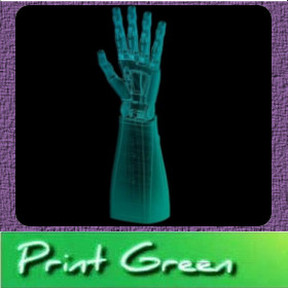 Designing a robotic arm is an idea that is quite easy to think of yet hard to implement. For most geeks who can definitely create one anytime they wanted given the materials they need, developing a robotic arm is quite a breeze. But for someone who doesn't have much experience and idea about it and who only got an inspiration to create one, that is more noble and admiring. From a Science Fair, a 17-year old geek, Easton LaChapelle was inspired by a competitor who wore a prosthetic arm that unfortunately it needs to be replace to complement her body as she grew up. He used it as an inspiration and took his self-made robotic arm to a much higher level. From a robotic arm made of LEGO materials, his goal was to develop a fully functional prosthetic arm for a very affordable value. LaChapelle was successful to create a prosthetic arm with the use of LEGO materials, fishing wire and surgical tubing. With the help of 3D printing technology, he made it into success offsetting the expensive costs of having a prosthetic arm. A Teensy Arduino micro-controller was used along with an amplifier circuits and Bluetooth receivers. The basic movements that the prosthetic arm can execute reacts according to - muscle flexing and blinking the eyes, it's also equipped with an EEG headset that measures the brainwaves to control the arm movements. Through the use of a 3D printer - PrintBot, a few parts were created except for the gears, motors and screws, which brought a total of $250 overall cost. Now your dream to have an affordable prosthetic arm is now reachable with the creation of LaChapelle's robotic prosthetic arm. Heineken recognized his creation and asked LaChapelle to produce about 5,000 pieces of his robotic arm for their bars to serve beers to their customers. Well it seems that after utilizing the application of 3D printing technology to produce human organs through stem cell, creating prostheses with the help of 3D printers are now getting into the hype. But let's assume that these technology will be more useful as it is not only for those who will benefit using it, but also for the environment. Like the printing industry lately, an agreement to green their business particularly the printer manufacturing business was supported by the largest names in the printing industry. Complying to the agreement leads to manufacturing green printer consumables such as eco-friendly toner cartridges and ink cartridges, as well as going green in their production of equipments. While the components being used and produce in 3D printing technology may possibly harm our environment, they should at least find a better way to create useful necessities and equipments without making any negative impacts that would affect the environment.
 Going green has no limit or no extent, small communities or big companies, they are all turning into a greener environment and practices. Several industries nowadays have already switched to a better environmental friendly manufacturing and services. Since there are several individuals and small organizations that started it all, why not those big names in the industry must not follow. Supporting the voluntary agreement by the biggest printer manufacturers in the printing industry, the European Commission has accepted to GO GREEN in their industry. They favored the agreement to set a target on greatly reducing the EU industry's carbon footprint emission in terms of printing and copying. Promoting proper recycling of reusable devices and printer consumables such as ink and toner cartridges, as well as improving energy efficiency of such printing devices, ink, toner and paper usage/consumption. The said major manufacturers complied to commit on promoting and bolster to encourage the utilization of "Duplex" (double-sided) printing as well as "N-up" (several pages per sheet) printing in order to cut down the use of paper materials. The full list of printer manufacturers that will sign up with the voluntary agreement are as follows:Brother Konica Minolta Okidata Toshiba
Canon Kyocera Panasonic Xerox
Dell Mita Ricoh
Epson Europe Lexmark Samsung
Hewlett-Packard Murata Machinery Sharp The Commission said: "The voluntary agreement has undergone a thorough impact assessment and we have concluded that it could be considered equivalent to binding regulations adopted under the EU’s 2009 Ecodesign Directive."While William Dazy, the Chairman of EuroVAprint, said : “We welcome the Commission’s endorsement of our voluntary agreement in the context of the Ecodesign Directive,
We are looking forward to further cooperation with the EU institutions in this area.”
The listed big names in the printing industry that participated in the said agreement have set up the "EuroVAPrint Organization", this will check and evaluate each companies effort towards a greener industry. Thus, we may expect a great improvement in their operations and productions in terms of being environmentally conscious. We should give credit to those printer manufacturers that had been accepting printer cartridges recycling for such a long time even before this agreement came out. Eco-friendly toner cartridges and ink cartridges, as well as recycled printer paper materials will certainly help on reducing carbon footprint and negative impacts that the print industry have brought from the past years.
Have you ever sold something very important that you've been keeping for years, just to buy an expensive gift for your special someone? Well I commend you for doing such a thing, just like Jonathan Brand, a long time owner of a late 60's Ford Mustang car model which he sold just to afford buying an engagement ring for his future better half. The car was actually so much worthy for him that he and his father had restored it for so many years just to keep its beauty. But on the day that he decided to settle down with the women of his life, he painstakingly let go of his treasure over a ring. Then realizing the agony of loosing his Mustang, he became so determined to recreate it, with the use of inkjet papers and printouts.
As it turn out, after loosing such a memorable keepsake, he then transformed as an artist and recreate his Ford Mustang through his memories with it. Of course Brand created a CAD model of his car on a computer and from that structure he started assembling each parts with the use of papers and glue. The replica was called "One Piece At A Time". If you're familiar with Johnny Cash, he also had a song entitled One Piece at a Time, thus naming his remodeled car with that title is actually an honor to the said song. Surprisingly the song was about an assembly line worker who cleverly built a Cadillac from stolen parts, one piece at a time.
Brand explained his fragile creation :
“The details of the car are based more on my memory and a few photographs, I no longer have access to the original car and chose not to use a surrogate to measure and get all the details correct. I like when things are slightly off, in the wrong place or missing, just like my memories of the original.”
Using the CAD model he created, three-dimensional drawings were printed out using a large scale inkjet printer, then one piece at a time he constructed remodeling his Mustang with paper pieces and some glue. The colors from the printed materials were actually inks, thus it makes a really costly project. It was more of like a jigsaw puzzle where his 3D drawings are the pieces which he fold and glued until he came out with this awesome Ford Mustang fragile replica. I wonder if he used recycled paper materials or old printouts, but I hardly doubt, since his cutouts are in printed in full color. But let's supposed he equipped the printer with bio-based ink cartridges or eco-friendly toner cartridges to reduce harmful effects once his jaw dropping creation worn-out and reach its disposal limit.
Soy ink as it became more popular in the printing industry, has also brought a few misconceptions and notions, one of which is the false idea of thinking that this type of ink is actually made of pure soy components. Now to shed some light on this matter, let's deal with some of the facts and mistakes that come along with soy inks. First, are soy inks really made of pure soy products? If somebody says yes, that is a mere misconception, literally ink products composed of oil, pigments, resins and other various components that makes an ink material. Certainly it's a soy based ink, but not purely made of soy. Carcinogens are also required to produce ink products, a mineral pigment used for black color inks. Aside from the fact that inks commonly comprise of renewable materials, there are also a few components required in the process of making this material that can't be renewed easily, one good example of which is petroleum. Although there were ink products emerging in the market that claimed to be made of organic materials, petroleum in ample amounts are still considerably added to ink compounds. When comparing the actual volatile organic compound emissions of conventional ink products over soy-based inks, there's still an argument with regards to this matter. Soy is considered a vegetable, and oils that come from vegetable products when cross link tend to dry out, during the process it emits volatile organic compounds. But given those ideas, conventional inks used in many printer nowadays can still emit and produce more volatile organic compounds. Printouts made from soy-base inks aid better paper recycling, a line that anyone of us might have read from most articles talking about soy ink products. There's an accurate study conducted with regards to this assumption, a laboratory study from Midwestern University proved that soy-based ink can be easily remove from paper pulp during the recycling process. However, during the study they only used a 4 week old printed material, while based from another study, it reveals that soy inks when aged onto the paper pulp, it penetrates stronger which makes it harder to be removed. Soy-based inks are biodegradable, but are they really the most convenient option when it comes to environment-friendly printing? Sustainability wise, the answer would probably be yes. But it is just the ink that was re-invented, how about the cartridge which is more concerning. As we all know, printer cartridges are made of plastic components, and to be able to manufacture plastic, non-renewable and minerals are used and consumed. I think instead of debating about the real deal between soy inks versus conventional inks, it would be better if we put more attention on the recycling process of the material from where the ink houses. If you're asking what could be the most possible environmentally-efficient printer consumable, how about we combine vegetable-based inks with recycled printer cartridges, that would be far more greener. Recycled eco-friendly toner cartridges, ink cartridges and other remanufactured printer supplies are all beneficial for the environment.
|


 RSS Feed
RSS Feed